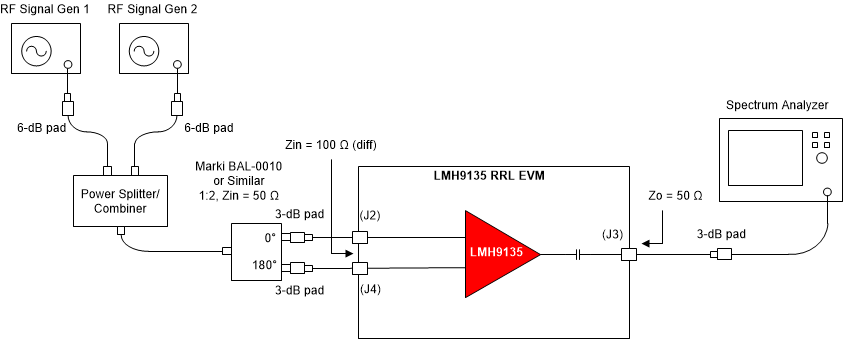SNLU284 May 2020 LMH9135
3.4 Two-Tone OIP3 Test Setup
 Figure 3-4 OIP3 Test Setup
Figure 3-4 OIP3 Test SetupUse the following guidelines for two-tone OIP3 measurement:
- As Figure 3-4 shows, combine two signal generator outputs using an in-phase power splitter and combiner. A 6-dB attenuator is recommended at the signal generator outputs to prevent the generators from coupling to each other and resulting in signal generator IMD3 spurs.
- Set both the signal generator outputs to a power level and frequency spacing such that it would yield the desired output power (POUT) at the device.
- TI recommends that the output power level is within the linear operation range of the LMH9135 device. As a general rule, it is recommended to keep the total output power level approximately 6 dB to 8 dB lower than the 1-dB compression point. For example, if the output 1-dB compression point of the device is 16 dBm, then set the signal generators such that each of the fundamental output power results in 2 dBm per tone.
- For the OIP3 test, the two tones can be spaced at 10 MHz apart from each other and on either side of center frequency.
- TI recommends setting the spectrum analyzer attenuation setting from 20 dB to 26 dB based on its sweet spot and the incoming input power level.
- Keep spectrum analyzer RBW and VBW settings identical for main tone and IM3 products.
- For output IP3 calculation, take into account combined losses at the desired frequency band between the LMH9135 device output to the spectrum analyzer input. The combined power losses include loss due to PCB output trace, RF coax cable, and attenuator pad used for external matching. The calculated OIP3 is given by the following equation:
Output IP3 = (PIN_SA – IMD3) / 2 + PIN_SA + PLOSS
where,
- PIN_SA = Input power per tone into the spectrum analyzer
- PLOSS = Power loss from the device output to the spectrum analyzer input
- IMD3 = Higher power of the two inter-modulation distortion products recorded at either 2f1 – f2 or 2f2 – f1
- Note: PIN_SA + PLOSS = POUT is the amplifier output power per tone.